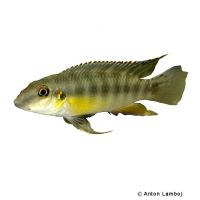Yellow Kribensis Kolente (Wallaceochromis humilis 'Kolente')
| Yellow Kribensis Kolente Wallaceochromis humilis 'Kolente' | |
|---|---|
| Name | Yellow Kribensis Kolente |
| Name Lat. | Wallaceochromis humilis 'Kolente' |
| Synonym | Pelvicachromis humilis 'Kolente' |
| Family | Cichlids |
| Family lat. | Cichlidae |
| Order | Cichlids |
| Order lat. | Cichliformes |
| Origin | Guinea |
| Habitat | Streams |
| Diet | Omnivore |
| pH | 5.0-7.0 |
| Behavior | Semi-aggressive |
| Keeping | Pair |
| Care Level | Moderate |
| Reproduction | Cave spawner |
| Breeding | Moderately difficult |
| Life Span | 3-5 years |
| Protection | No |
| Metric Units | |
| Size | ♀ 10 cm, ♂ 15 cm |
| Temperature | 24-27 °C |
| Hardness | 5-12 °dH |
| Aquarium | ~ 200 l |
| US Units | |
| Size | ♀ 4", ♂ 6" |
| Temperature | 75-81 °F |
| Hardness | 89-214 ppm |
| Aquarium | ~ 50 gal |
Distribution and habitat
The Kolente Redbreast is a site variant that occurs in Guinea, in the Kolente River basin. There they live in oxygen-rich, slow-flowing jungle streams.
Maintenance
The aquarium should offer many hiding places, such as stones, roots and caves (e.g. halved coconuts), have some robust plants for decoration and free swimming space. Soft, slightly acidic water and a dark substrate of sand or gravel covered with some foliage (sea almond leaves) is ideal.
No ammonia, ammonium and nitrite should be detectable, the nitrate value should not exceed 100 mg/l. To ensure the water quality and oxygen content, a filter and heater adapted to the aquarium size is required, as well as lighting for the species-appropriate day-night rhythm of the animals.
Diet
The food supply consists of dry, live and frozen food. For a balanced diet, feed at least once daily with a high quality sinking dry food for cichlids (flakes, granules, pellets) as well as cyclops, daphnia, artemia, etc. (live or frozen). In addition, they need vegetable food, such as algae leaves, algae wafers, over-scalded leafy and wild vegetables or dry food with high vegetable content (spirulina).
Only feed as much as will be eaten within a few minutes. A regular and varied diet promotes health and increases resistance.
Behaviour and compatibility
The quiet, somewhat shy fish form solid pairs and defend their territory very emphatically during the spawning season. Keeping several pairs is only recommended in a larger and richly structured tank. They can be well socialized with not too lively fish.
Basically, only compatible fish species with similar demands on water quality and water temperature may be socialized.
Sex dimorphism
The male is larger, more colorful and has much longer, pointed fins. The female is slightly smaller and rounder.
Reproduction and breeding
They are cave breeders and usually attach the spawn to the cave ceiling or walls. The female performs brood care, while the male defends the territory (parental family). The fry hatch after 2-3 days and swim freely after 7-8 days. Both parents continue to guard the fry for some time and lead them to feeding sites in the aquarium before brood care ends
Fry must be fed several times a day with special rearing food (Artemia nauplii). In community tanks breeding is hardly possible, because the fry are easy prey.
Important
Different site or color varieties should not be maintained together as undesirable crosses (hybridization) may occur.
The addition of peat extract or filtration via peat promotes the well-being and increases the color intensity of the animals.
The well-being of the fish should be checked regularly. Temperature should be checked daily, pH, hardness and nitrate levels should be checked at least every 14 days. Regular partial water changes are recommended, even if the contaminant level has not yet reached the upper limit. Sudden changes in water quality should be avoided. Newly introduced fish must be accustomed slowly to the water in the aquarium.
Further literature can be found in your pet store.
References
Text: Werner Winter; Image: Anton Lamboj
Source: BMELV (1998): Tierschutzgutachten - Haltung von Zierfischen (Süßwasser); BAENSCH & RIEHL (2004): Aquarien Atlas Bd. 2, Mergus Verlag; ENGELMANN (2005): Zootierhaltung - Tiere in menschlicher Obhut: Fische, Verlag Harri Deutsch
- Gemäß § 21 Abs. 5 Tierschutzgesetz idgF
